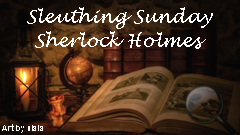Sherlock Holmes didn’t take off as a popular character with his second novel, “The Sign of Four” (sometimes titled “The Sign of the Four,” 1890); that wouldn’t happen until Arthur Conan Doyle moved his sleuth over to the short-story form.
But we see many mystery genre tropes in play as the author improves on his first effort from three years prior, “A Study in Scarlet.” (And don’t worry, this novel recovered in popularity: Wikipedia lists 16 TV and film adaptations, seven radio dramatizations and one play.)
The case comes to him
Instead of a police detective calling on him to consult, a woman named Mary Morstan – who will hit it off with Watson — stops in at 221B Baker Street to hire Holmes because she’s been inexplicably receiving valuable pearls in the mail. She thinks it’s related to her father, who disappeared four years ago. Later, Agatha Christie’s Poirot would acquire many cases in this walk-in fashion.

“The Sign of Four” (1890)
Author: Arthur Conan Doyle
Series: Sherlock Holmes No. 2
Genre: Mystery
Setting: London, 1890
The police, in this case Inspector Athelney Jones, are a necessary annoyance for Doyle in his creation of Holmes as a “detective’s consultant,” rather than a private eye. Indeed, the whole concept is tongue-in-cheek, because of course it’s Holmes who truly solves the cases. Holmes himself gets amusement and value out of the official’s simple-mindedness.
After Jones arrests the entire household of a murdered man – a former colleague of Mary’s father – simply because they were at the scene of the crime (that they themselves called in, on Holmes’ urging), Holmes and Watson wonder how close they themselves were to being arrested.
Later, the fact that Jones – so lauded by the local papers for his diligence – is on the wrong path works in Holmes’ favor. He can now investigate without being too panicked about the time crunch, knowing the criminals won’t have urgency to leave London since Jones is not on their trail.
Better structure, more mood
In terms of structure and mood, “The Sign of Four” is a step up from “A Study in Scarlet.” That book lags midway when Doyle pauses the progression of the case to give a backstory and reason for the culprit’s actions.
This time, the case has consistent forward momentum, and it’s only at the end that the treasure-driven culprit explains why he did it – and by that time, we have a reason to be interested. (Again, though, this isn’t a pure mystery like Christie would usually do; instead, the pleasure is in Holmes’ putting clues together to reconstruct what happened.)
Doyle smoothly blends a moody, gaslit vibe of 1890 London; good at the time but great when read today as we absorb details such as lanterns on the sides of horse-drawn carriages and steam-powered riverboats. The nighttime riverboat chase is considered a classic of action-adventure writing and I can’t quibble; Doyle describes the pursuit in crisp and exciting fashion.

Holmes’ world gets built up in this second novel. His street urchin helpers – “Arabs” in the parlance of the times – get a name, the Baker Street Irregulars (a moniker that Holmes fandom later took up for themselves). Doyle recognizes that Holmes needs a network of informants, and this is a brilliant way to make use of invisible members of society.
Watson meets his match
We get one of those old-literature lightning-fast progressions from meeting to marriage between Watson and Mary, with Watson’s only hangup being his fear that she’ll think he’s a gold digger (she is the beneficiary of the treasure, if it can be recovered). It’s old-fashioned but natural and cute.
The animal kingdom gets better treatment here than in the novels surrounding it – “Scarlet,” where a dog is used as a science experiment, and “The Hound of the Baskervilles,” where the hound is monstrous. In “Sign of Four,” Holmes rents a bloodhound, Toby, from a colleague who supplies them for this purpose, and uses him to track a clue.
Foreign races don’t fare so well, especially with the passage of time, but it is fascinating to learn about a race from an isolated island off the coast of India known for their small stature, vicious temperament and a rejection of colonialism so thorough that the Brits give up on the island. Doyle almost sounds like he’s describing a missing link between ape and human when he speaks of the man’s climbing skills.
The author doesn’t seem too bothered by his country’s imperialism in India (neither was Christie, when writing later). But by the same token, the Sign of Four refers to a pact between a white man and three men from East Asia, so that’s somewhat refreshing. And while they are criminals, the concluding narration by the lead criminal shows he’s not pure evil; he was reacting to his circumstances.
As was also the case in “Scarlet,” Doyle is interested in thoroughly showing the motivations of a criminal’s actions so we may at least understand them, and perhaps sympathize.
Addictive personality, addictive storytelling
Speaking of psychological issues: Somewhat surprising for an 1890 novel, “Sign of Four” touches upon drug addiction via its main character, as Holmes takes cocaine. This is because – while he’s totally in his element when working on a case (not even needing to sleep much) – he can’t abide the downtime when nothing is happening.
Poirot would later sit still and let his little gray cells get their exercise, but Holmes is addicted to steady forward progress – something reflected by Doyle’s wonderfully brisk pacing. He’s extremely intellectual, but also of the “worker bee” persuasion.
Doyle would soon acquire that reputation, too, cranking out monthly Holmes short stories for magazines; being the popular format of the time, this is when the detective would grow into an icon. In retrospect, though, Holmes’ iconic traits are already in place after two novels.
As a typical modern reader who prefers novels to shorts, it’s a shame I’m already halfway through the catalog of four Holmes novels. I’ll look on the bright side, though: Bring on the short stories.
Sleuthing Sunday reviews the works of Agatha Christie, along with other new and old classics of the mystery genre.

